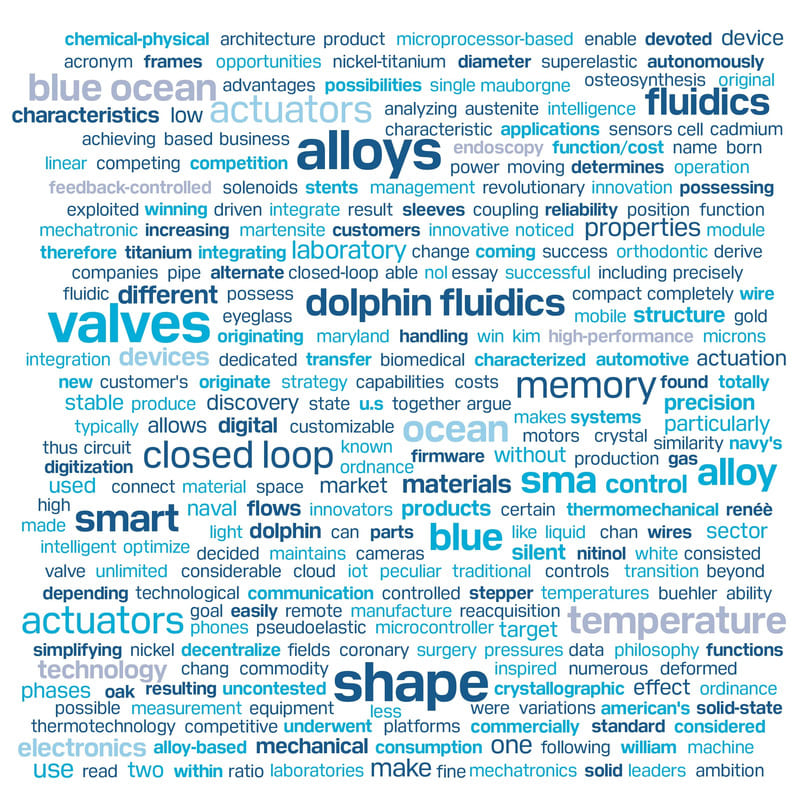Blue Ocean Technology
Winning without competing. W. Chan Kim and Renéè Mauborgne argue in the essay Blue Ocean Strategy that companies devoted to innovation win "without any competition, in an uncontested market space of unlimited possibilities, like a blue ocean".
We are inspired by this philosophy with the ambition to produce not standard valves but innovative and revolutionary devices based on the integration of smart materials, precision fluidics and digital microcontroller electronics that can optimize the function/cost ratio in the target market.
In the blue ocean of fluidics digitization through our products we enable new business opportunities with the goal of coming together with our customers innovators and leaders in precision liquid and gas control.
Smart valves
Dolphin Fluidics valves are born as mechatronic products by integrating shape memory alloy-based actuation, microprocessor-based electronics for closed-loop control of flows and IoT communication module for remote management and data transfer into a single device. Therefore, each product is considered "smart" because they are able to be controlled through dedicated "firmware," and have the ability to connect to "cloud" systems and "mobile" platforms. Our technology allows customizable capabilities for each device to the customer's target function; through its digital electronics, it is the valve itself that controls flows, pressures or temperatures autonomously. This makes it possible to "decentralize" intelligence within each machine or fluidic circuit by simplifying its architecture, thus increasing reliability at competitive costs.
Learn more about the use and operation of smart valves here.
Contact us for more information about our services and products
Shape memory alloys
Shape memory alloys (SMA) are intelligent materials characterized by possessing thermomechanical properties such as shape memory effect and pseudoelastic effect, which have no similarity to any other known alloy.
These properties originate from the peculiar crystallographic structure that maintains two phases, one stable at low temperature (martensite) and one stable at high temperature (austenite). These phases possess different chemical-physical characteristics and mechanical properties; it is as if the alloy consisted of two "different" materials that alternate depending on their originating temperature.
It is precisely the transition from one solid state to the other that determines the variations in characteristics that are exploited to make particularly high-performance and totally silent "solid-state" actuators.
SMA alloys derive from a 1932 discovery, American's Chang and Read, were analyzing an alloy of gold and cadmium and noticed that the material was easily deformed up to a certain temperature and underwent a change in crystal structure beyond that temperature, resulting in the reacquisition of its original shape.
In 1963, William Buehler found the same characteristic in the nickel-titanium alloy in his laboratory at the U.S. Navy's Naval Ordinance Laboratories (NOL) in White Oak, Maryland. As a result of his discovery, it was that him that decided to name it NiTiNOL, including the acronym of the laboratory in which he worked (NIckel TItanium Naval Ordnance Laboratory).
Shape memory alloys have numerous applications in different technological fields. In mechatronics and thermotechnology, they are used to make devices that integrate the functions of sensors and actuators such as smart valves, linear actuators for automotive and cameras for cell phones, and to make sleeves for pipe coupling. In the biomedical sector, SMA alloys are used with considerable success for the production of orthodontic wire, coronary stents, for the manufacture of devices for osteosynthesis and equipment for use in endoscopy and surgery. In the commodity sector, eyeglass frames made from superelastic SMA alloys have been particularly successful commercially.
Dolphin Fluidics' Smart valves use fine wires from 100 to 200 microns in diameter for fluidics handling and control. The use of such technology allows for no mechanical moving parts, as in traditional valves driven by solenoids or DC or stepper motors, achieving the following advantages:
- Compact and very light actuators
- Very low power consumption, typically less than 3W
- Feedback-controlled actuation through position measurement
- Completely silent operation
Would you like to know more about our advanced technology?
Contact us for more information

Contact request
Thank you for your interest Error processing your request. Please retry or contact us.

)